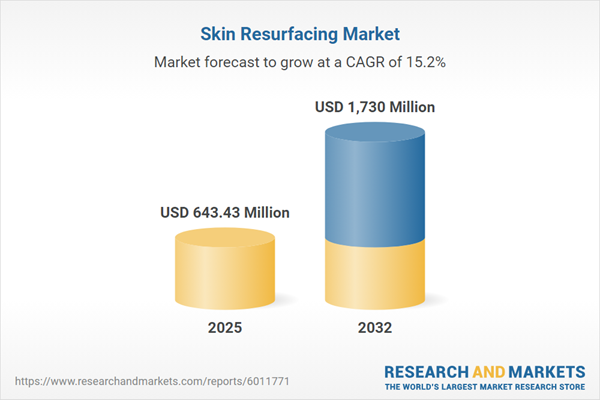Speak directly to the analyst to clarify any post sales queries you may have.
Senior decision-makers in the skin resurfacing market encounter a rapidly shifting landscape shaped by new patient preferences, technological progress, and evolving regulations. Navigating these changes with strategic agility and operational focus is essential for sustaining a competitive edge.
Market Snapshot: Skin Resurfacing Market Growth and Trends
The skin resurfacing market is witnessing strong momentum, supported by increasing demand for minimally invasive cosmetic procedures and continuous innovation. In 2024, the market is valued at USD 558.86 million, with projections indicating substantial acceleration to USD 643.43 million by 2025 and an anticipated CAGR of 15.24%. Looking further ahead, the sector is forecast to reach USD 1.73 billion by 2032.
This growth reflects persistent clinical advancement, evolving user needs, and heightened emphasis on patient safety and compliance with global standards. Organizational shifts toward efficiency and technology-driven solutions are setting new benchmarks across the sector.Scope & Segmentation: Comprehensive Skin Resurfacing Market Overview
- Technology: Chemical peels target precise exfoliation requirements, while dermabrasion procedures—both manual and motorized—offer customizable outcomes for a broad patient population. Lasers, including ablative, non-ablative, and fractional systems, provide adaptable approaches for various skin conditions. Crystal and diamond microdermabrasion devices serve texture refinement, and radiofrequency or high-intensity focused ultrasound solutions are favored for their gentle, non-invasive applications, especially in sensitive demographics.
- End User: Dermatology practices, medical spas, and aesthetic centers are leaders in implementing innovative technologies, setting priorities on patient satisfaction and clinical standards. The adoption of home-use devices is growing, enhancing accessibility and compelling manufacturers to improve remote support services and meet stringent safety requirements.
- Distribution Channel: Hospitals and specialty clinics are primary buyers for advanced devices, while retail outlets and digital sales channels expand market reach. Digital engagement supports product education and facilitates adoption in both clinical and consumer segments.
- Application: Solutions address hyperpigmentation, scarring, wrinkle reduction, photoaging, and significant texture improvements, serving both cosmetic and therapeutic needs. Expansion into broader clinical indications highlights growing recognition beyond aesthetics alone.
- Geographical Coverage: The Americas, particularly the United States, Brazil, and Mexico, feature high adoption rates and stringent regulatory observance. The EMEA region balances regulatory variation with sustained demand for modern procedures, while Asia-Pacific markets such as China, India, Australia, and Japan demonstrate rapid technology uptake and rising operational needs, strengthening their role in global expansion.
- Leading Companies Profiled: Industry leaders including Lumenis Ltd., Hologic, Inc., Candela Corporation, Cutera, Inc., Sisram Medical Ltd., Lutronic Co., Ltd., InMode Ltd., Sciton, Inc., Fotona d.o.o., and Solta Medical, Inc. shape sectoral standards in innovation, quality, and responsiveness.
Key Takeaways: Strategic Insights for Senior Decision-Makers
- Diversifying across leading-edge technologies supports market resilience and enables consistent outcomes in clinical, spa, and at-home segments.
- Prioritizing data-driven safety validation fosters practitioner trust and ensures alignment with shifting regulatory expectations.
- Leveraging digital advancements, such as artificial intelligence for diagnostics and workflow improvements, enables tailored care and operational efficiency.
- Integrating ethical sourcing and sustainable product design addresses stakeholder expectations around environmental and corporate practices, elevating reputational value.
- Customizing marketing and distribution approaches enhances organizational agility, enabling effective response to regional regulatory changes and fluctuating demand.
- Collaboration among manufacturers, distributors, and clinical professionals—supported by targeted education—facilitates adaptation to operational shifts and supports consistent compliance worldwide.
Tariff Impact: Navigating Shifts in Supply Chain and Cost Structure
Recently implemented U.S. tariffs on imported skin resurfacing devices are prompting a strategic review of supply chain and procurement approaches. Organizations are addressing these challenges by expanding domestic sourcing, strengthening supply chain agility, and providing bundled packages that include equipment, services, and training. These measures help offset disruption and preserve cost-effectiveness amid regulatory change.
Methodology & Data Sources
This report draws upon direct interviews with industry leaders, analysis of peer-reviewed literature, and current regulatory documentation. Methodologies include SWOT assessments, Porter’s Five Forces, and stakeholder workshops, with triangulation reinforcing the validity of insights for senior executive strategy.
Why This Report Matters
- Enables senior executives to anticipate and navigate regulatory transitions, while embracing advanced technological solutions for sustainable differentiation.
- Equips investors to identify technology trends and gain a nuanced understanding of geographic dynamics for informed investment planning.
- Clarifies evolving demand patterns and segments, supporting enhanced strategic decision-making and streamlined operational performance across diverse market contexts.
Conclusion
This analysis delivers timely intelligence for leaders seeking to strengthen market position and ensure compliance in an environment defined by constant transformation. The insights provided empower forward-looking growth and adaptability.
Additional Product Information:
- Purchase of this report includes 1 year online access with quarterly updates.
- This report can be updated on request. Please contact our Customer Experience team using the Ask a Question widget on our website.
Table of Contents
3. Executive Summary
4. Market Overview
7. Cumulative Impact of Artificial Intelligence 2025
Companies Mentioned
The companies profiled in this Skin Resurfacing market report include:- Lumenis Ltd.
- Hologic, Inc.
- Candela Corporation
- Cutera, Inc.
- Sisram Medical Ltd
- Lutronic Co., Ltd.
- InMode Ltd.
- Sciton, Inc.
- Fotona d.o.o.
- Solta Medical, Inc.
Table Information
| Report Attribute | Details |
|---|---|
| No. of Pages | 191 |
| Published | October 2025 |
| Forecast Period | 2025 - 2032 |
| Estimated Market Value ( USD | $ 643.43 Million |
| Forecasted Market Value ( USD | $ 1730 Million |
| Compound Annual Growth Rate | 15.2% |
| Regions Covered | Global |
| No. of Companies Mentioned | 11 |









